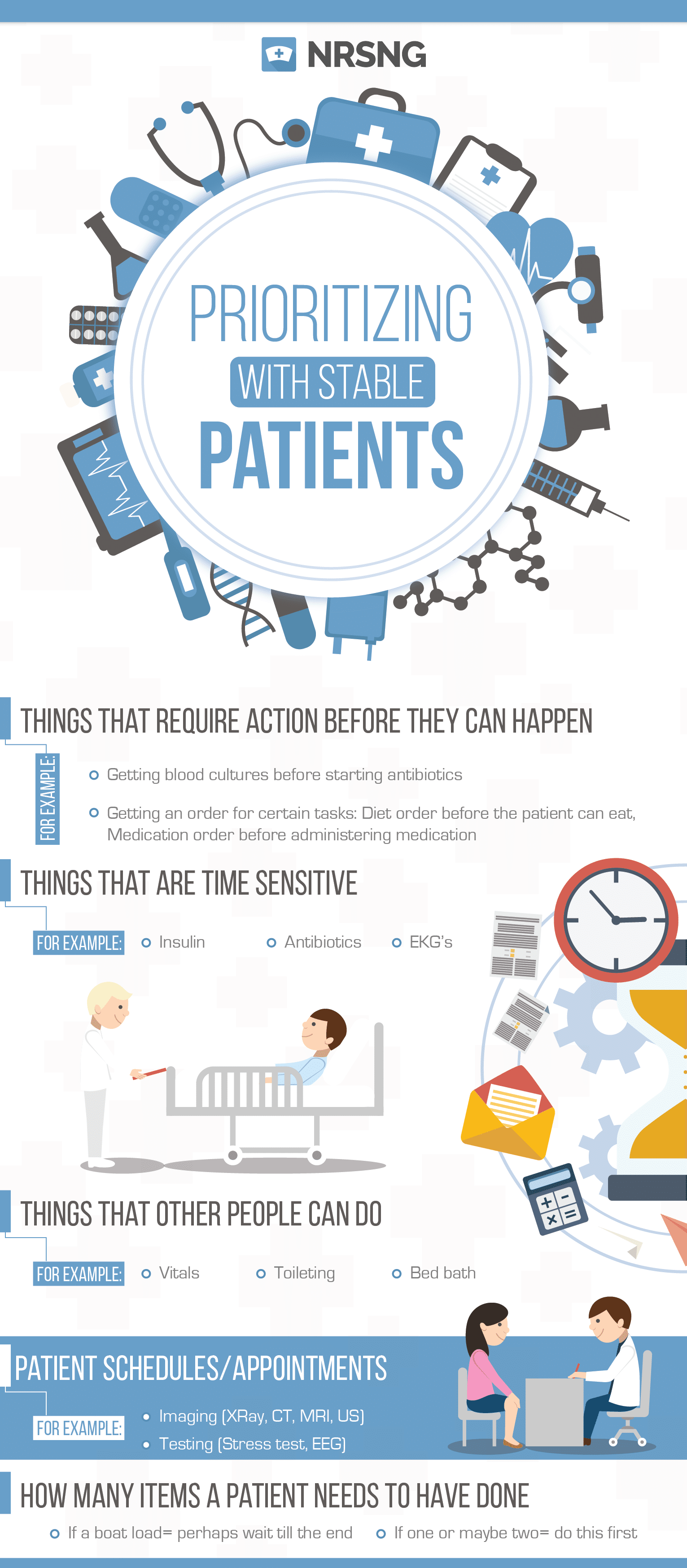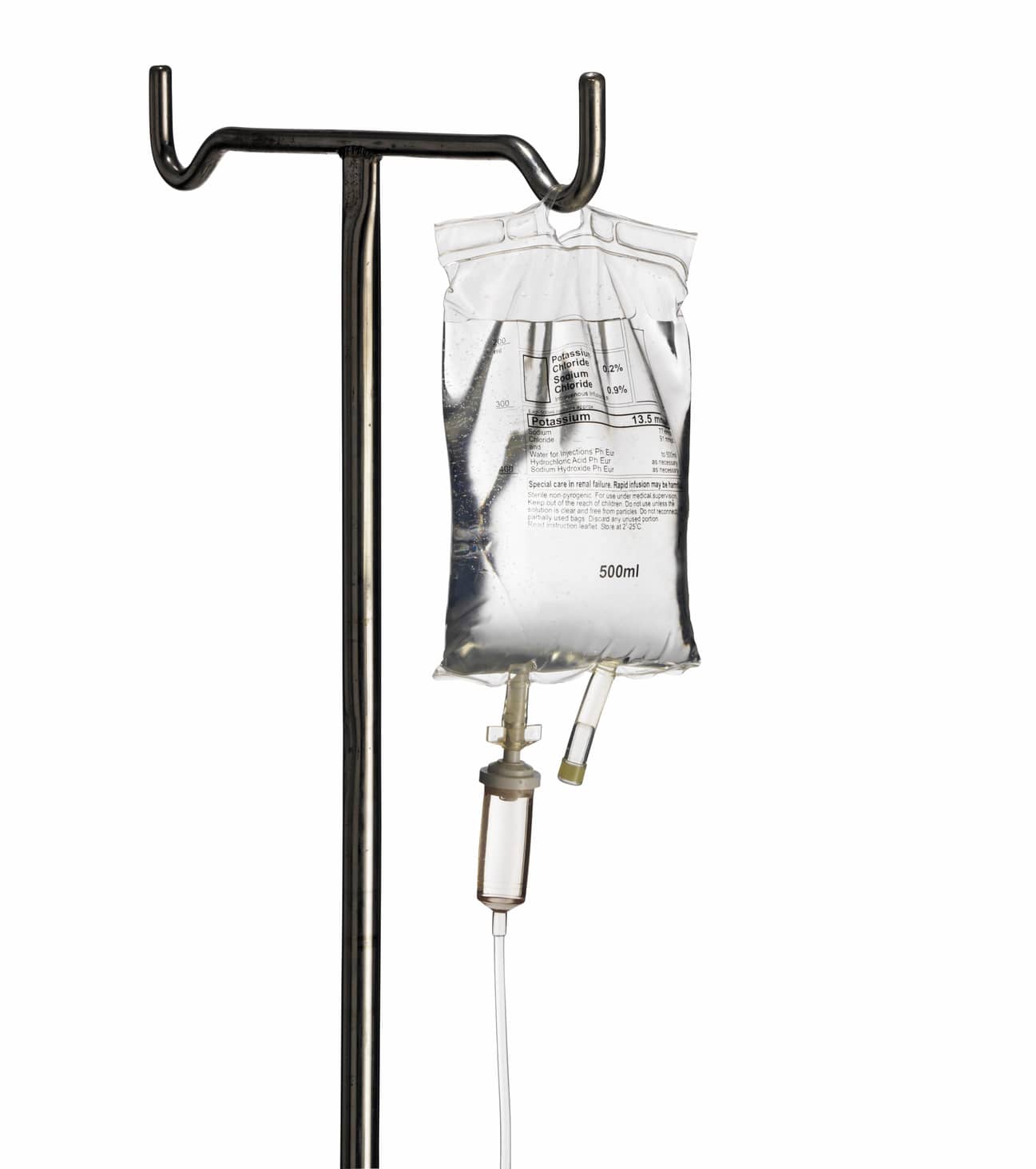Provide the Best Nursing Care (Nursing Prioritization) | NURSING.com

It is obvious who you should see first if there is an airway, breathing or circulation problem, but what if the ABC’s are stable? Is there a DEFG continuation? Some other way to learn and remember what to do first if everyone is stable?

Unfortunately, the short answer is no. The long answer is sort of. Below I have compiled a list of things to consider when creating the plan for what to do first when every one is stable.
Making your nursing plan
Once all life threatening situations are taken care of, you need to evaluate your list of tasks and make a plan. In order to properly construct a plan you should consider the following:
Things that require action before they can happen
- For example:
- Getting blood cultures before starting antibiotics
- Getting an order for certain tasks:
- Diet order before the patient can eat
- Medication order before administering medication
Things that are time sensitive
- For example:
- Insulin
- Antibiotics
- EKG’s
Things that other people can do
- For example:
- Vitals
- Toileting
- Bed bath
Patient schedules/appointments
- For example:
- Imaging (XRay, CT, MRI, US)
- Testing (Stress test, EEG)
How many items a patient needs to have done
- If a boat load= perhaps wait till the end
- If one or maybe two= do this first
- Consider, if a patient needs to get a work note or something simple and then they can leave, if possible prioritize this first. That way you can be respectful of their time.

Grouping nursing activities
The goal of grouping activities is to enter rooms once if possible. This cuts down on your time majorly. If you can prepare everything prior to going into a room, such as an IV and pain medications at once, you will be that much quicker. If you needed to get a flu swab on a patient and they would like a cup of water, get them the water before you get their flu swab and deliver the water while you get the swab.
Using experienced nurses advice
All members of the team have experiences that you can learn from (including you)-Not everything is health care related per se, it might be a personal experience. For example: you are giving a patient a shower and you gather two towels, one for the body and one for the hair/head because that is something you personally need.
If another nurse suggests another way to accomplish a task, try it.
If it doesn’t work for you, then don’t do it the next time, but I strongly suggest trying something before you decide to not do it. The main reason is that it keeps a good relationship with your fellow co-workers, but it also allows you to remain open to all suggestions. This is important in health care because it is always changing.
Example of prioritizing
Report:
- Ms. Jones is 88 years old, yesterday she was trying to go to the bathroom and she got tripped up in a rug, falling on her right side bumping her head on the side table. No blood thinners, CT and XRays negative. One hematoma to the right side of her head. She received 4 mg of Morphine and 4 mg of Zofran. Her pain was re-checked 30 minutes ago and was 0/10. Vital signs are stable. She needs to ambulate down the hallway to make sure she can walk steadily and then she will be discharged home.
- Mr. Smith is a 40 year old male who came in with chest pain for 2 days. His EKG was normal sinus rhythm and his 0-hour troponin was negative. He will need a troponin redraw in 1 hour. He has received 324 of aspirin and 2 mg of morphine. His pain level remains a 4/10, but he denied any more pain medication at this time. Vital signs are stable.
- Ms. Patterson is 25 years old, she has had abdominal pain for the past 3 days. Last bowel movement was 5 days ago. She has been constipated in the past and so she took a laxative to help her have a bowel movement with no luck. She needs to get an abdominal XRay, IV, IV pain medication and blood work.
Tasks:
- Ambulate Ms. Jones down the hallway and assess gait stability.
- Re-draw Mr. Smith’s troponin in 1 hour.
- IV and blood work for Ms. Patterson
- IV pain medication for Ms. Patterson
- Get an appointment for an abdominal XRay for Ms. Patterson
Are there things that require action before they can happen?
- IV before being able to give IV pain medication

Are there things that are time sensitive?
- Troponin re-draw in one hour
Are there things that other people can do?
- Depends on your unit, some techs can do the trop re-draw, some units need the phlebotomist to draw the blood. But for the sake of this example, we will say that it can be delegated.
Are there any things that require an appointment time?
- Abdominal XRay needs an appointment
How many items per room need to be accomplished?
- Ms. Jones: 1
- Mr. Smith: 1
- Ms. Patterson: 3
So like I mentioned before, there are many different paths to take to accomplish this. Some nurses are going to think their way is THEE way, I personally think that it doesn’t really matter, it just matters what is the most efficient to you and your patients.
How I would accomplish this list of tasks:
I would step into Mr. Smith’s room first because although he is stable, he has the biggest potential to become unstable. Introduce myself, get a rhythm strip from the cardiac monitor to confirm he is still in normal sinus rhythm, ask him about his chest pain (has it changed?), and then let him know that we are waiting on his troponin collection to occur in one hour.
Next I would lay eyes on Ms. Jones and let her know that I would be taking over as her nurse and will be taking her for a walk after I medicate my other patient for their pain (patients and family members are usually very understanding if you let them know you are going to address another person’s pain).
I would then delegate to my tech the blood draw, gather materials for Ms. Patterson’s IV, blood work and get her pain medication. After starting the IV and getting the blood work, I would administer the pain medication.
While walking to send the blood work to lab I would call XRay and request an appointment. Then I would take Ms. Jones on her walk, assess her gait. This cannot be delegated because you must assess her while she walks. I would report off to the physician the results and then confirm that the troponin was drawn on Mr. Smith at the proper time and was sent off.
There is an argument to be made that I didn’t need to stop to see the first two patients before I implemented my plans. However, I always lay eyes on my patients before I do anything because the patient may have become diaphoretic during report or some other game changer that causes a change in the plan. This is all in how you practice with your license, but once you sign onto those patients, their condition is your responsibility.
For more help with time management check out Everything You Need to Know About Nursing Time Management


.png?width=50&height=50&name=image%20(11).png)



